Introduction to PHP7.0 installation in Linux environment
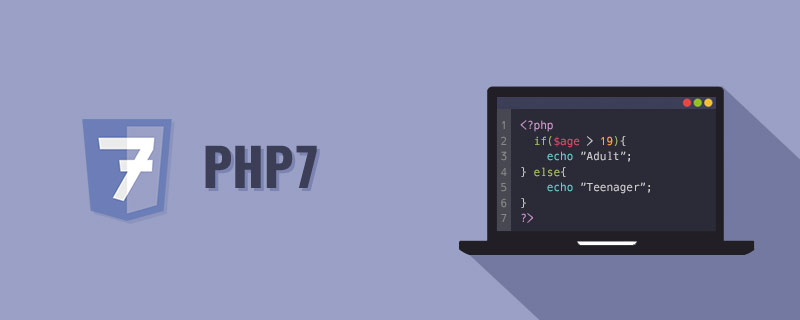 Comparison between PHP7 and HHVM
Comparison between PHP7 and HHVM
The performance of PHP7 in real scenarios is indeed equivalent to that of HHVM, and even exceeds HHVM in some scenarios. The operation and maintenance of HHVM is complex and it is a multi-threaded model. This means that if a thread causes a crash, the entire service will hang and it will not automatically restart. In addition, it uses JIT, which means that it needs to be warmed up after restarting. Without preheating, the performance will be worse. Moreover, the multi-threaded model is difficult to debug, which is very unsuitable for web services that pursue stability.
For versions before Nginx and PHP7.0, please refer to this article: Linux environment Nginx installation and debugging and PHP installation
The official version of PHP7.0 has been released around November 2015, and is currently PHP7.0.2 version, I first started following the first beta version of php7 in August 2015, and now the official version is released.
linux version: 64-bit CentOS 6.6
Nginx version: nginx1.8.0
php version: php-7.0.2
Recommended ( Free): PHP7
##Downloadwget http://php.net/get/php-7.0.2.tar.gz/ from/a/mirror
It is recommended to read the installation help file before installation INSTALLUnzip the installationtar zxvf php-7.0.2.tar .gz
cd php-7.0.2
First check the installation help./configure --help
./configure --prefix=/usr/local/php \
–with-curl –with-freetype-dir
– with-gd
–with-gettext
–with-iconv-dir
–with-kerberos
–with-libdir=lib64
–with-libxml-dir
–with- mysqli
–with-openssl
–with-pcre-regex
–with-pdo-mysql
–with-pdo-sqlite
–with-pear
–with-png- dir
–with-xmlrpc
–with-xsl
–with-zlib
–enable-fpm
–enable-bcmath
–enable-libxml
–enable-inline -optimization
–enable-gd-native-ttf
–enable-mbregex
–enable-mbstring
–enable-opcache
–enable-pcntl
–enable-shmop
–enable-soap
–enable-sockets
–enable-sysvsem
–enable-xml
–enable-zip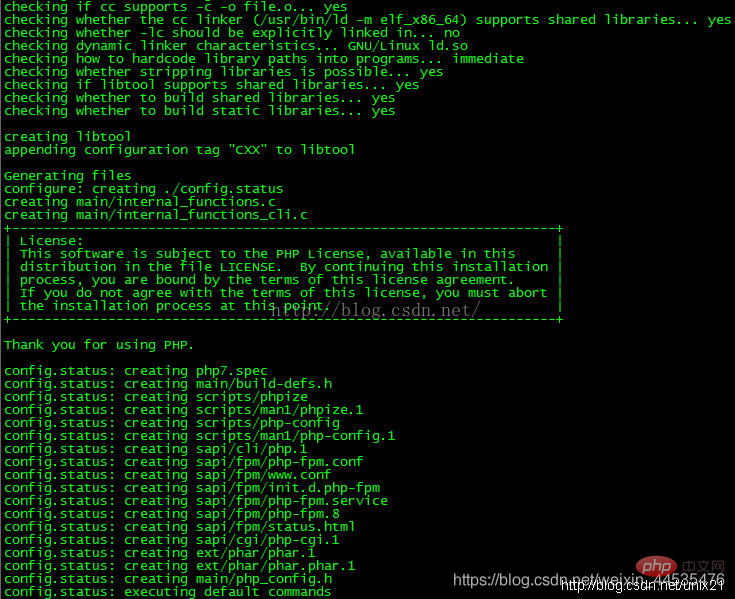 If the configuration is wrong, you need to install the required Module, install dependent libraries directly with yum
If the configuration is wrong, you need to install the required Module, install dependent libraries directly with yum
yum -y install libjpeg libjpeg-devel libpng libpng-devel freetype freetype-devel libxml2 libxml2-devel mysql pcre-devel
Note: There are several configurations that cannot be configured when installing php7beta3. You need to yum it. This is no longer the case with php-7.0.2.yum -y install curl-devel
yum -y install libxslt-devel
Compile and installmake && make install
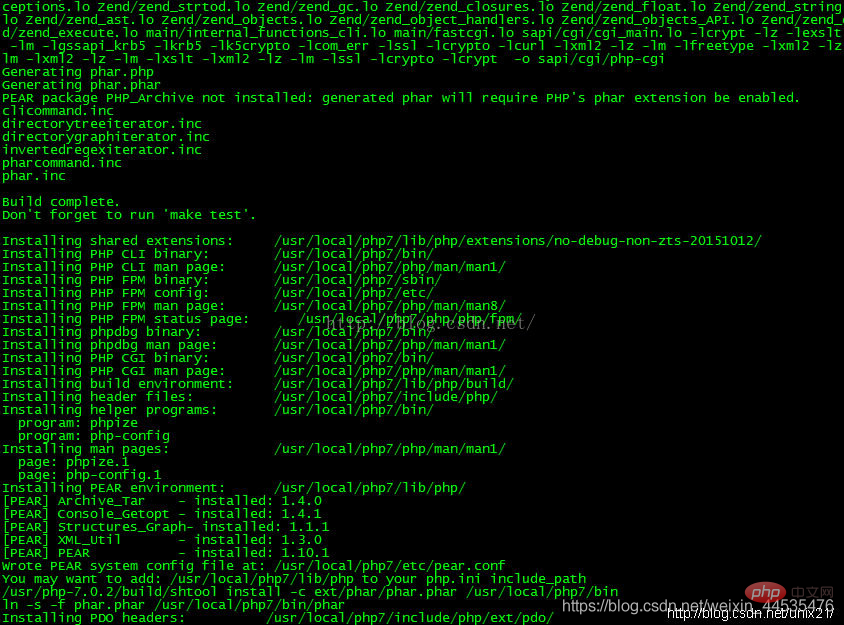
cp php.ini-development /usr/local/php /lib/php.ini
cp /usr/local/php/etc/php-fpm.conf.default /usr/local/php/etc/php-fpm.conf
cp /usr/local/php/etc/php-fpm.d/www.conf.default /usr/local/php/etc/php-fpm.d/www.conf
cp -R ./sapi/fpm/php-fpm /etc/init.d/php-fpm
It should be noted that www in php7 The .conf configuration file configures the port number and other information of phpfpm. If you modify the default 9000 port number, you need to change it here, and then change the nginx configuration Start
/etc/init.d /php-fpm
View phpinfo()
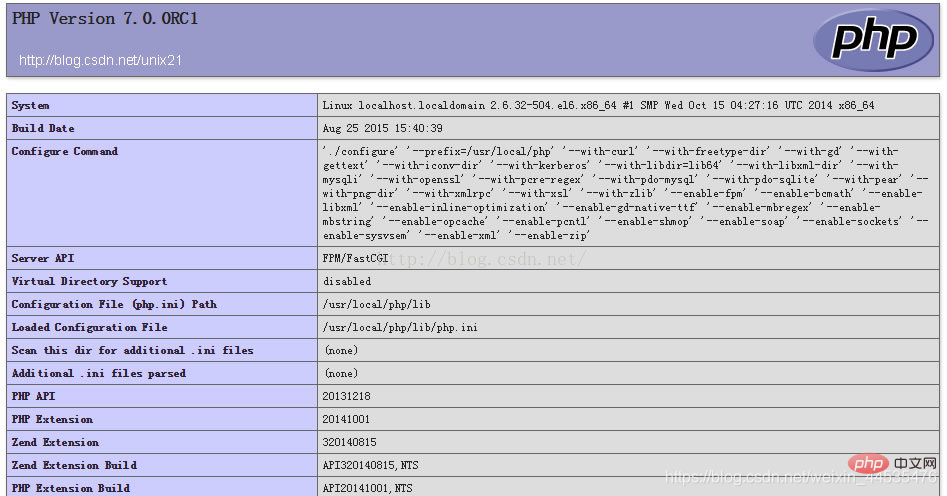
php7 and php5 performance analysis comparison
[root@localhost www5.4.44]# time /usr/local/php5.4.44/bin/php search_by_key.php
user 0m0.300s
sys 0m0.050s
[root@localhost www]# time /usr/local/php/bin/php search_by_key.php
real 0m0.361s
user 0m0.304s
sys 0m0.057s
[root@localhost www7]# time /usr/local/php7/bin/ php search_by_key.php
real 0m0.114s
user 0m0.097s
sys 0m0.017s
Official website address: http://php.net/opcache
Use the following recommended settings to obtain better performance:
opcache.memory_consumption=128
opcache.interned_strings_buffer=8
opcache.max_accelerated_files=4000
opcache.revalidate_freq=60
opcache.fast_shutdown=1
opcache.enable_cli=1
You can also disable opcache.save_comments and enable opcache.enable_file_override. It should be reminded that the above configuration must be rigorously tested before being used in a production environment. Because there is a known issue with the above configuration, it will cause exceptions in some frameworks and applications, especially when there are documents using comment annotations.
vim /usr/local/php7/etc/php.ini
Join
zend_extension=/usr/local/php7/lib/php /extensions/no-debug-non-zts-20141001/opcache.so
restart
killall php-fpm
/etc /init.d/php-fpm
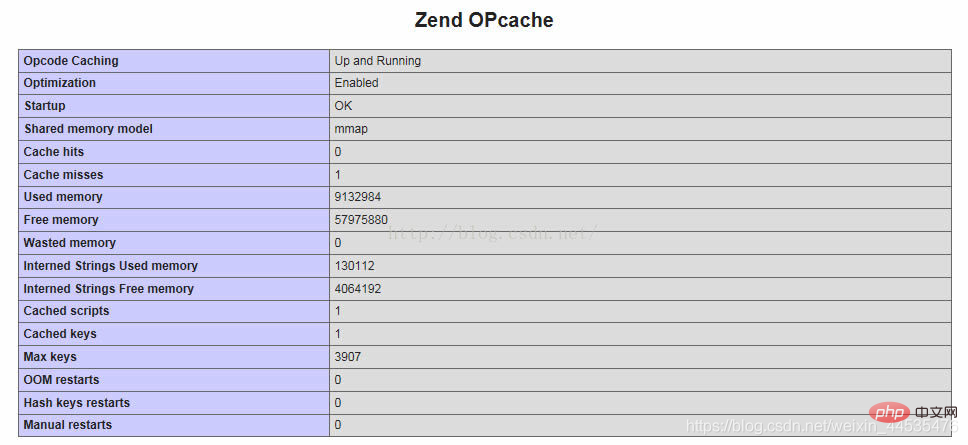
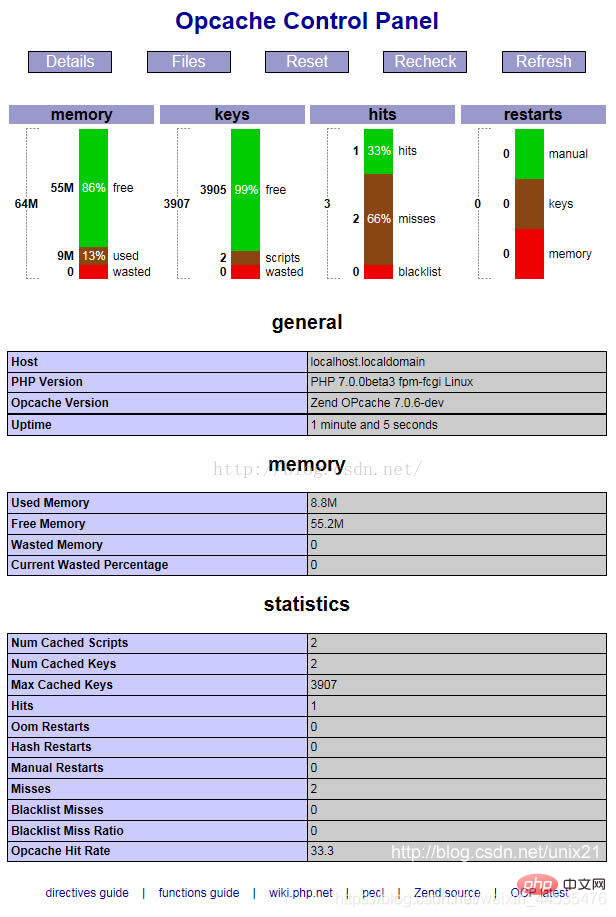
Opcache status test code (https://gist.github.com/ck-on/4959032) Give a demo:
<?php /*
OCP - Opcache Control Panel (aka Zend Optimizer+ Control Panel for PHP)
Author: _ck_ (with contributions by GK, stasilok)
Version: 0.1.6
Free for any kind of use or modification, I am not responsible for anything, please share your improvements
* revision history
0.1.6 2013-04-12 moved meta to footer so graphs can be higher and reduce clutter
0.1.5 2013-04-12 added graphs to visualize cache state, please report any browser/style bugs
0.1.4 2013-04-09 added "recheck" to update files when using large revalidate_freq (or validate_timestamps=Off)
0.1.3 2013-03-30 show host and php version, can bookmark with hashtag ie. #statistics - needs new layout asap
0.1.2 2013-03-25 show optimization levels, number formatting, support for start_time in 7.0.2
0.1.1 2013-03-18 today Zend completely renamed Optimizer+ to OPcache, adjusted OCP to keep working
0.1.0 2013-03-17 added group/sort indicators, replaced "accelerator_" functions with "opcache_"
0.0.6 2013-03-16 transition support as Zend renames product and functions for PHP 5.5 (stasilok)
0.0.5 2013-03-10 added refresh button (GK)
0.0.4 2013-02-18 added file grouping and sorting (click on headers) - code needs cleanup but gets the job done
0.0.2 2013-02-14 first public release
* known problems/limitations:
Unlike APC, the Zend OPcache API
- cannot determine when a file was put into the cache
- cannot change settings on the fly
- cannot protect opcache functions by restricting execution to only specific scripts/paths
* todo:
Extract variables for prefered ordering and better layout instead of just dumping into tables
File list filter
*/
// ini_set('display_errors',1); error_reporting(-1);
if ( count(get_included_files())>1 || php_sapi_name()=='cli' || empty($_SERVER['REMOTE_ADDR']) ) { die; } // weak block against indirect access
$time=time();
define('CACHEPREFIX',function_exists('opcache_reset')?'opcache_':(function_exists('accelerator_reset')?'accelerator_':''));
if ( !empty($_GET['RESET']) ) {
if ( function_exists(CACHEPREFIX.'reset') ) { call_user_func(CACHEPREFIX.'reset'); }
header( 'Location: '.str_replace('?'.$_SERVER['QUERY_STRING'],'',$_SERVER['REQUEST_URI']) );
exit;
}
if ( !empty($_GET['RECHECK']) ) {
if ( function_exists(CACHEPREFIX.'invalidate') ) {
$recheck=trim($_GET['RECHECK']); $files=call_user_func(CACHEPREFIX.'get_status');
if (!empty($files['scripts'])) {
foreach ($files['scripts'] as $file=>$value) {
if ( $recheck==='1' || strpos($file,$recheck)===0 ) call_user_func(CACHEPREFIX.'invalidate',$file);
}
}
header( 'Location: '.str_replace('?'.$_SERVER['QUERY_STRING'],'',$_SERVER['REQUEST_URI']) );
} else { echo 'Sorry, this feature requires Zend Opcache newer than April 8th 2013'; }
exit;
}
?>nbsp;html>
<p>
</p><h1 id="a-Opcache-Control-Panel-a"><a>Opcache Control Panel</a></h1>
<p>
<a>Details</a>
<a>Files</a>
<a>Reset</a>
<?php if ( function_exists(CACHEPREFIX.'invalidate') ) { ?>
<a>Recheck</a>
<?php } ?>
<a>Refresh</a>
</p>
<?php
if ( !function_exists(CACHEPREFIX.'get_status') ) { echo '<h2>Opcache not detected?'; die; }
if ( !empty($_GET['FILES']) ) { echo '<h2 id="files-cached">files cached</h2>'; files_display(); echo 'The above is the detailed content of Introduction to PHP7.0 installation in Linux environment. For more information, please follow other related articles on the PHP Chinese website!

Hot AI Tools

Undresser.AI Undress
AI-powered app for creating realistic nude photos

AI Clothes Remover
Online AI tool for removing clothes from photos.

Undress AI Tool
Undress images for free

Clothoff.io
AI clothes remover

AI Hentai Generator
Generate AI Hentai for free.

Hot Article

Hot Tools

Notepad++7.3.1
Easy-to-use and free code editor

SublimeText3 Chinese version
Chinese version, very easy to use

Zend Studio 13.0.1
Powerful PHP integrated development environment

Dreamweaver CS6
Visual web development tools

SublimeText3 Mac version
God-level code editing software (SublimeText3)

Hot Topics
 1377
1377
 52
52
 Unable to log in to mysql as root
Apr 08, 2025 pm 04:54 PM
Unable to log in to mysql as root
Apr 08, 2025 pm 04:54 PM
The main reasons why you cannot log in to MySQL as root are permission problems, configuration file errors, password inconsistent, socket file problems, or firewall interception. The solution includes: check whether the bind-address parameter in the configuration file is configured correctly. Check whether the root user permissions have been modified or deleted and reset. Verify that the password is accurate, including case and special characters. Check socket file permission settings and paths. Check that the firewall blocks connections to the MySQL server.
 Can mysql run on android
Apr 08, 2025 pm 05:03 PM
Can mysql run on android
Apr 08, 2025 pm 05:03 PM
MySQL cannot run directly on Android, but it can be implemented indirectly by using the following methods: using the lightweight database SQLite, which is built on the Android system, does not require a separate server, and has a small resource usage, which is very suitable for mobile device applications. Remotely connect to the MySQL server and connect to the MySQL database on the remote server through the network for data reading and writing, but there are disadvantages such as strong network dependencies, security issues and server costs.
 Unable to access mysql from terminal
Apr 08, 2025 pm 04:57 PM
Unable to access mysql from terminal
Apr 08, 2025 pm 04:57 PM
Unable to access MySQL from the terminal may be due to: MySQL service not running; connection command error; insufficient permissions; firewall blocks connection; MySQL configuration file error.
 What is the most use of Linux?
Apr 09, 2025 am 12:02 AM
What is the most use of Linux?
Apr 09, 2025 am 12:02 AM
Linux is widely used in servers, embedded systems and desktop environments. 1) In the server field, Linux has become an ideal choice for hosting websites, databases and applications due to its stability and security. 2) In embedded systems, Linux is popular for its high customization and efficiency. 3) In the desktop environment, Linux provides a variety of desktop environments to meet the needs of different users.
 CentOS Interview Questions: Ace Your Linux System Administrator Interview
Apr 09, 2025 am 12:17 AM
CentOS Interview Questions: Ace Your Linux System Administrator Interview
Apr 09, 2025 am 12:17 AM
Frequently asked questions and answers to CentOS interview include: 1. Use the yum or dnf command to install software packages, such as sudoyumininstallnginx. 2. Manage users and groups through useradd and groupadd commands, such as sudouseradd-m-s/bin/bashnewuser. 3. Use firewalld to configure the firewall, such as sudofirewall-cmd--permanent-add-service=http. 4. Set automatic updates to use yum-cron, such as sudoyumininstallyum-cron and configure apply_updates=yes.
 How to learn Linux basics?
Apr 10, 2025 am 09:32 AM
How to learn Linux basics?
Apr 10, 2025 am 09:32 AM
The methods for basic Linux learning from scratch include: 1. Understand the file system and command line interface, 2. Master basic commands such as ls, cd, mkdir, 3. Learn file operations, such as creating and editing files, 4. Explore advanced usage such as pipelines and grep commands, 5. Master debugging skills and performance optimization, 6. Continuously improve skills through practice and exploration.
 Key Linux Operations: A Beginner's Guide
Apr 09, 2025 pm 04:09 PM
Key Linux Operations: A Beginner's Guide
Apr 09, 2025 pm 04:09 PM
Linux beginners should master basic operations such as file management, user management and network configuration. 1) File management: Use mkdir, touch, ls, rm, mv, and CP commands. 2) User management: Use useradd, passwd, userdel, and usermod commands. 3) Network configuration: Use ifconfig, echo, and ufw commands. These operations are the basis of Linux system management, and mastering them can effectively manage the system.
 Cannot start mysql in xampp
Apr 08, 2025 pm 03:15 PM
Cannot start mysql in xampp
Apr 08, 2025 pm 03:15 PM
There are many reasons why XAMPP fails to start MySQL, including port conflicts, configuration file errors, insufficient system permissions, service dependency issues, and installation issues. The troubleshooting steps are as follows: 1) Check port conflicts; 2) Check configuration files; 3) Check system permissions; 4) Check service dependencies; 5) Reinstall MySQL. Follow these steps and you can find and resolve issues that cause MySQL startup to fail.




